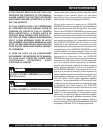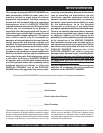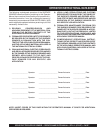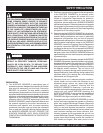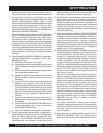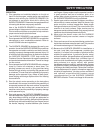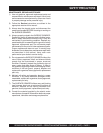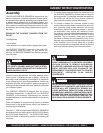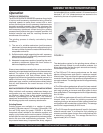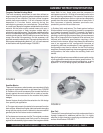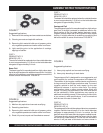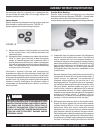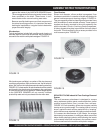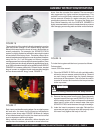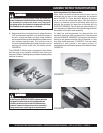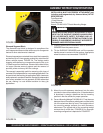
SFG10E ELECTRIC SURFACE GRINDER — OPERATION AND PARTS MANUAL — REV. #1 (07/16/07) — PAGE 13
ASSEMBLY INSTRUCTIONS/OPERATIONS
Operation
THEORY OF OPERATION
The SFG10E SURFACE GRINDERS operate on the principle
of various multi-accessory attachments being utilized at
rotational speeds to make direct contact with a work
surface. Various types of multi-accessory attachments are
secured to a recess provided in the rotating, aluminum disc
located on the bottom of the machine. The specific type of
multi-accessory attachment utilized during the grinding
process directly affects the type of material removed, the
material removal rate and the resulting flatness and
smoothness of the surface.
The grinding process is directly controlled by these
conditions:
1) The use of a suitable mechanism (multi-accessory
attachment) of proper design and configuration to grind
the work surface and remove material while delivering
acceptable service life.
2) Sufficient static weight supporting the multi- accessory
attachment to allow it to effectively penetrate the work
surface and remove material.
3) Adequate horsepower capable of propelling the multi-
accessory attachment against the work surface to
deliver acceptable productivity rates.
Since no two materials are exactly alike, no two work surface
materials can be penetrated and removed by the exact same
method. The nature of the grinding process, along with
operator experience, skill and common sense, would
suggest that efficient and productive material removal is a
matter of trial and error. Combinations of multi-accessory
attachment type, condition, and feed rate are direct factors
that will also determine the overall success of the job
application.
MULTI-ACCESSORY ATTACHMENTS AND APPLICATIONS
While individual multi-accessory attachment design and
configuration may vary, basic operational characteristics
are identical: impact upon a work surface material and
remove a percentage of the material. This common
operational characteristic has led to the development of
the following popular multi-accessory attachments:
Grinding Stones
Grinding stones are available in a number of grades,
including: C06 extra coarse, C10 coarse, C24 medium, C80
fine and C120 super fine grade. FIGURE 4. All stones
incorporate silicon carbide as the abrasive medium and
employ a clay binder as the matrix material. Vitrified type
stones utilize an oven baking process that produces greater
service life over other manufacturing processes. As the
clay material wears away, it exposes new, sharp, edges of
the imbedded silicon carbide material. All stones have the
identical 2" x 2" X 4" dimensions and are secured to the
machine by the use of a plastic wedge.
FIGURE 4
The designation system for the grinding stones utilizes a
system similarly utilized for most abrasive products: the
larger the number, the finer the grain structure and usually,
the smoother resulting finish.
a) The C06 and C10 coarse grade stones are the most
popular utilized stones and result in maximum material
removal rates. They are utilized for general grinding and the
removal of trowel marks, high spots and rough sections on
concrete surfaces. The average service life is approximately
4 to 10 hours.
b) The C24 medium grade stone will result in lower material
removal rates. It is utilized for finer finish grinding of concrete
and rough grinding on terrazzo and other types of stone
floor configurations. The average service life is approximately
6 to 10 hours.
c) The C80 fine grade stone will result in still lower material
removal rates. It is utilized for polishing concrete and
medium grinding on terrazzo and other types of stone floor
configurations with a water/slurry mixture only. The average
service life is approximately 8 to 20 hours.
d) The C120 super fine grade stone will result in the lowest
material removal rates. It is utilized for final polishing on
terrazzo and other types of stone floor configurations with
a water/slurry mixture only. The average service life is
approximately 40 to 75 hours.



